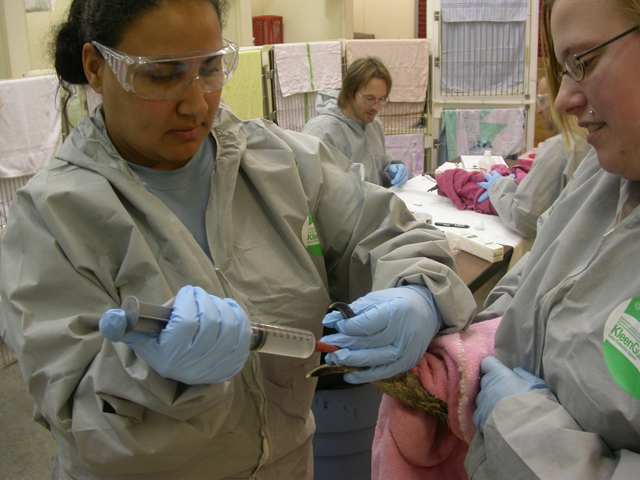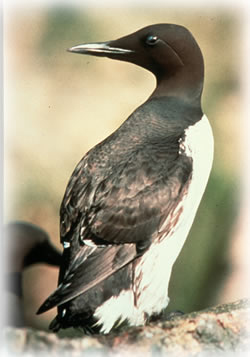
Shower hoses hang from the ceiling. In basins below, murres, scoters, grebes and gulls endure various and gentle cycles of soap, rinse and dry administered by trained technicians in rubber gloves and “moonsuits.” Washed – or “rehabilitated” – birds rest in heated, bassinet-type cages. While the room is awash in the scents of dishwashing soap and fresh warm towels, the overwhelming aroma is of guano – fish-eaters’ guano – with hints of fuel oil.
Meanwhile, rehabbed birds wait outside in above-ground swimming pools for their final recovery and release back to the wild.
(Situated along California’s North Coast and a part of California’s Oiled Wildlife Care Network, the MWCC has responded to two major incidents. Combined, about 1,100 live birds were brought in for treatment, and a similar number were found dead. Of those that arrived alive, about 43 percent survived to be rehabilitated and released.)

And then what? Once released, do they survive to breed? Do they promptly perish? The questions have arisen again in the wake of the Deepwater Horizon spill in the Gulf of Mexico. Simply put: Does cleaning birds work? Should we bother?
For clues, biologists and others responding to the Gulf spill are reviewing http://www.owcn.org/research/post-release-studies">research conducted by Humboldt State wildlife professor Rick Golightly and others. In a pioneering study of a 1997 spill of crude oil and other petroleum products near California’s Point Arguello, the biologists put radio transmitters on oiled western gulls that had been cleaned, on non-oiled gulls that had been cleaned, and on an unoiled and uncleaned control group. Upon release, the birds were tracked for an average of six months – until their radio batteries died. The study (published in Wildlife Society Bulletin in 2002) indicated no difference in survivorship among the gull groups – and a survival rate of 100 percent.
But gulls and murres are, comparatively speaking, like apples and oranges. Gulls, a fixture among beaches and piers and people, may be tougher, more tolerant of handling. Murres spend nearly their entire lives swimming on the surface and diving, and they do not do as well in captivity.

So, after a 1999 spill of fuel oil off Humboldt Bay, Golightly and colleagues examined the impact of removing oil from common murres. They attached transmitters to 31 oiled and rehabilitated murres – and to 25 non-oiled, non-treated birds as a control group. While radio failures limited measurements of long-term survival, transmissions indicated that about 70 percent of the oiled birds survived at least 80 days. However, in the first days after release, more of the rehabbed oiled birds died than did the unoiled birds. Later, after a few weeks, the survival rate of rehabbed oiled murres was similar to the others.
Biologists are quick to note that these are relatively small samples amid countless variables: species, time of year, type of oil, ocean currents, bird behavior, nesting habitats, weather and more.
Wildlife biologist Tamar Danufsky coordinates Humboldt’s Marine Wildlife Care Center, which serves as a teaching facility when not in bird-rehab mode.
“We’re learning from each spill,” she said, “with the goal of continually improving husbandry and care protocols for oiled wildlife.”
She cites some clear keys to boosting survival rates: quick responses, trained technicians, dedicated facilities, and increased understanding of individual species’ nutritional and behavioral needs.
Over the past 15 years, California’s Oiled Wildlife Care Network has trained thousands of wildlife-response volunteers, including about 600 at Humboldt’s facility. Some of them are in the Gulf.
According to Danufsky, “We are lucky to live in California, where spill-response infrastructure and preparedness are the best in the world.”
For more information:
Marine Wildlife Care Center at Humboldt State
http://www.humboldt.edu/mwcc/
Oiled Wildlife Care Network
http://www.owcn.org
California State University connections to oil spills and marine ecology
http://blogs.calstate.edu/cpdc_sustainability/?p=574
“For the Birds – HSU’s Marine Wildlife Care Center saves birds from an oily death.”
HSU news report, Feb. 8, 2008: http://now.humboldt.edu/news/for-the-birds1/
U.S. Fish & Wildlife Service: Effects of Oil on Wildlife and Habitat
http://www.restorethegulf.gov/library/assets/rtg_oil_effects_on_wildlif…